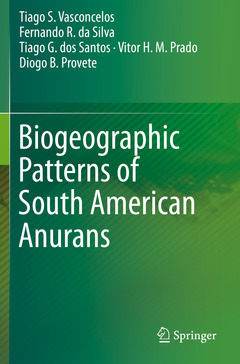Biogeographic Patterns of South American Anurans, 1st ed. 2019

TS Vasconcelos obtained his BS in Biological Sciences (2002) and MSc in Animal Biology (2005) both from the Sao Paulo State University (UNESP/Sao Jose do Rio Preto, SP, Brazil), and PhD in Biological Sciences-Zoology (2009) from the UNESP/Rio Claro (SP, Brazil). He was a post-doctoral fellow in the Department of Ecology and Evolutionary Biology at the University of California – Irvine (Prof. Dr. Bradford A. Hawkins’ lab: 2010-2011). From 2012 to 2016 he was a Young Researcher fellow at the Department of Biological Sciences (UNESP/Bauru, SP, Brazil). Currently, he is a post-doctoral fellow in the Department of Biological Sciences (UNESP/Bauru, SP, Brazil). His research focus on understanding patterns of species distributions in the Neotropics.
FR da Silva obtained his BS in Biological Sciences (2004) from the Sao Paulo State University (UNESP/Assis, SP, Brazil) and both MSc (2007) and PhD (2011) in Animal Biology from UNESP/São José do Rio Preto (SP, Brazil). He holds aProfessor position at the Department of Environmental Sciences, Federal University of São Carlos (UFScar/Sorocaba, SP, Brazil) since 2011. His research tries to understand the processes and mechanisms underlying amphibian species distribution at different spatial scales, focusing mainly on anuran species of Atlantic Forest and Cerrado.
TG Santos obtained his BS in Biological Science (2003) from Federal University of Santa Maria (UFSM, RS, Brazil), and both MSc in Animal Biology (2005) and PhD in Biological Sciences-Zoology (2009) from the São Paulo State University (UNESP, SP, Brazil). He spent one year as post-doctoral fellow from the São Paulo State University (UNESP/Rio Claro, SP, Brazil). Since 2010, he holds a Professor position at the Federal University of Pampa (UNIPAMPA). Currently, he also contributes to the Pos-Graduate Program in Animal Biodiversity of the Federal University of Santa Maria (UFSM), having mentored students for the MSc and PhD degrees in researcheson d
Date de parution : 09-2020
Ouvrage de 149 p.
15.5x23.5 cm
Date de parution : 09-2019
Ouvrage de 149 p.
15.5x23.5 cm
Disponible chez l'éditeur (délai d'approvisionnement : 15 jours).
Prix indicatif 105,49 €
Ajouter au panier


